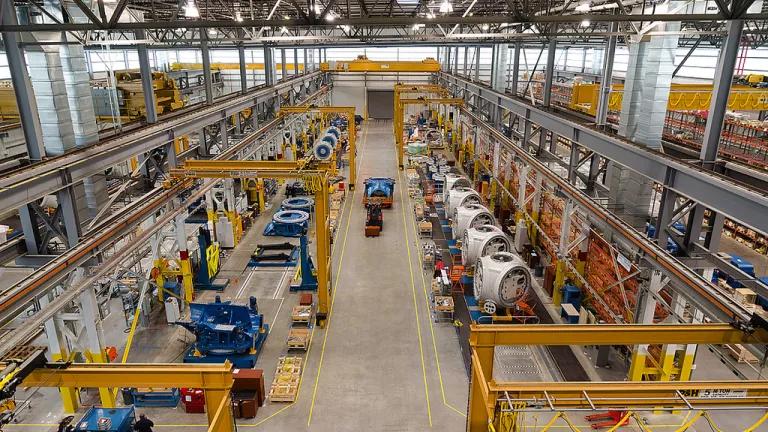Smart Manufacturing Helps Reduce Industrial Emissions

Humanity really started messing with the global climate system during the industrial revolution when we started burning coal to meet rising energy demand from industrial manufacturing. Most industrial energy efficiency programs target large manufacturers, which represent about 10 percent of all manufacturers and account for half of total industrial energy demand. But there still aren’t many programs out there to help small and medium manufacturers save energy through efficiency improvements, even though they constitute 90 percent of the manufacturing sector and account for the other half of industrial energy demand. Together, small, medium and large manufacturers drive about a third of harmful climate-warming emissions today.
Fortunately, members of Congress have introduced a bipartisan, bicameral bill to curb energy demand from small and medium manufacturers. If implemented, the Smart Manufacturing Leadership Act is estimated to save consumers $5 billion in energy costs by 2040 and reduce carbon emissions equal to the pollution coming from 116 million cars in a year.
Introduced last week by Senators Jeanne Shaheen (D-NH) and Lamar Alexander (R-TN), and Representatives Peter Welch (D-VT) and Tom Reed (R-NY), this bill would require the U.S. Department of Energy (DOE) to develop a national smart manufacturing plan and provide grants to small and medium manufacturers.
Smart manufacturing uses advanced technology to increase productivity and reduce energy waste and costs. For example, Cummins, an Indiana-based engine manufacturer, has invested in technology to convert energy from its engine testing facilities into electricity for its buildings, helping reduce the company’s energy intensity by 20 percent since 2010.
So far only large companies have the scale, budgets and resources to implement smart manufacturing technology and practices like these. This bill would help small- and medium-sized manufacturers do the same thing.
In addition to implementing a biennial national smart manufacturing plan within three years, DOE would also expand its technical assistance programs to include smart manufacturing technologies, provide $10 million per year over three years for state-level matching grants to help small- and medium- sized manufacturers optimize their energy performance, and create “Industrial Assessment Centers” to increase research collaboration between higher education institutions and DOE National Labs.
We need to cut industrial emissions
According to the IPCC, limiting global warming to 1.5°C above pre-industrial levels requires rapid transitions in industrial systems around the world. NRDC also recognizes the emissions reduction challenges facing the industrial sector. In its groundbreaking 2017 report, America’s Clean Energy Frontier: The Pathway to a Safer Climate Future, it states that “emissions reductions strategies vary greatly among subindustries, but a combination of operation and maintenance improvements and equipment upgrades could improve efficiency across the board.”
While helping U.S. businesses reduce energy demand and emissions, smarter manufacturing will also help improve readiness and resilience against the effects of climate change that will affect physical capital. The National Climate Assessment acknowledges that “extreme heat and weather can cause manufacturing equipment to break down with greater frequency, while rising sea levels and increased storm intensity can destroy equipment and property across all types of economic activities along American coastlines.”
Efficiency matters
Like energy efficiency, smart manufacturing makes good economic sense. It will save businesses money, increase productivity, and create advanced manufacturing jobs, which will keep the United States at the forefront of an increasingly competitive global economy. So far only large manufacturers have the scale, budgets and resources to implement smart manufacturing technology and practices like these. This bill would help small and medium manufacturers do the same thing.
From a climate action standpoint, energy efficiency is our best weapon because the cheapest and cleanest kilowatt-hour is the one you don’t have to generate. Through smarter manufacturing we can employ cross-cutting strategies to improve energy efficiency across all sectors. According to the National Climate Assessment, more can and needs to be done:
"The capacity for mitigation from individual and household behavioral changes, such as increasing energy end-use efficiency with available technology, is known to be large. Although there is capacity, there is not always broad acceptance of those behavioral changes, nor is there sufficient understanding of how to design programs to encourage such changes. Behavioral and institutional research on how such choices are made and the results evaluated would be extremely beneficial. For many of these efforts, understanding of cost and effectiveness is limited, as is understanding of aspects of public support and institutional performance; so additional support for studies of these activities is needed to ensure that resources are efficiently employed."
This applies to businesses as well, and the Smart Manufacturing Leadership Act helps meet this need. That is why NRDC supports the bill alongside a broad coalition of private sector and public interest organizations, including the National Association of Manufacturers, the American Council for an Energy-Efficient Economy (ACEEE), the Alliance to Save Energy, and the National Association of State Energy Officials, among many others.
More must be done to avoid the worst effects of global warming, but the Smart Manufacturing Leadership Act is a good start towards mitigating the original driver of human-caused climate change—industrial energy demand. We urge Congress to pass it.
